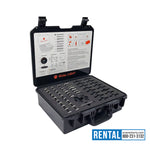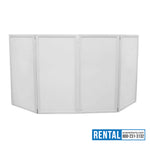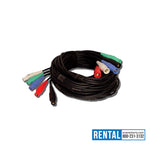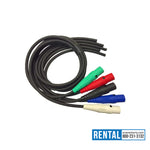You have no items in your shopping cart.
Large-scale events—whether music festivals, cultural fairs, sporting tournaments, or film shoots—rely on one thing to keep everything running smoothly: power. But when these events take place in remote areas, open fields, or venues with limited infrastructure, traditional power sources simply won’t cut it. That’s where Temporary Power Grids come in. Designed to be scalable, mobile, and efficient, Temporary Power Grids provide the infrastructure needed to support multi-day events with complex electrical demands. From lighting and sound systems to catering, security, and emergency services, everything needs to be powered safely and reliably. In this comprehensive guide, we’ll explore what Temporary Power Grids are, why they’re essential, how to plan one for a multi-day event, and the best practices that ensure safety, performance, and peace of mind.
What Are Temporary Power Grids?
Temporary Power Grids are modular electrical systems designed to provide power over a defined area for a limited period of time. They often include: - Generators (primary or backup power sources) - Power distribution units (PDUs or distro boxes) - Feeder and branch cabling - Transformers (if voltage conversion is needed) - Transfer switches and monitoring systems - Backup systems like battery packs or UPS units These systems are customized based on event size, duration, terrain, and specific electrical loads required by vendors, production crews, or event infrastructure. The goal is to mimic the safety and reliability of permanent power grids, but in a flexible, temporary setup that can be easily removed after the event concludes.
Why Temporary Power Grids Are Essential for Multi-Day Events
Multi-day events often demand a lot from their electrical systems. Over the course of several days, different areas of the event will need different amounts of power. Whether it’s stages with lighting rigs, food trucks, security lights, or temporary offices, the power grid must accommodate all of these simultaneously without failure. Temporary Power Grids are crucial because they allow event organizers to distribute power across a large area while ensuring that electrical demands are met and monitored. Additionally, they provide much-needed redundancy to prevent power loss from affecting critical operations. Multi-day events often involve a variety of activities happening simultaneously or in quick succession, making a stable power source vital for overall event success.
How to Plan for Temporary Power Grids
Planning a Temporary Power Grid for a multi-day event requires careful consideration of several factors, including the size and layout of the event, the type of equipment that needs to be powered, and the available space for setting up the grid. Start by assessing the total power requirements of the event. Consider all of the equipment that needs power, including lighting, sound systems, food vendors, mobile ticketing, air conditioning, emergency services, and more. Once you have the total power load, determine the number and size of generators required. Don’t forget to account for peak power loads, as equipment like amplifiers, projectors, and large LED screens may require more power during startup or at peak usage times. The next step is deciding where to place your Temporary Power Grids. Locations should be chosen based on accessibility, safety, and the distribution of power across the event. In addition, consider any local regulations regarding fuel storage, generator placement, and safety standards. Work with a qualified power technician to ensure that the grid is correctly sized and configured to meet the needs of your event.
Types of Equipment Used in Temporary Power Grids
A properly designed Temporary Power Grid includes a variety of specialized equipment, each serving a different purpose. - Generators: These are the heart of the power grid, providing the main source of electricity. There are different types of generators available, depending on the needs of the event. Diesel generators are common due to their reliability and fuel efficiency, but propane and natural gas generators are also used for smaller events or where noise reduction is necessary. - Power Distribution Units (PDUs): PDUs or distro boxes manage the distribution of electricity from the generators to different parts of the event. These units often feature multiple outlets and fuses to ensure safe operation, especially when powering sensitive equipment like soundboards or lighting rigs. - Feeder Cables: These heavy-duty cables carry power from the generators to the PDUs, lighting systems, and other infrastructure. It's important to use cables that are rated for the load and environment of the event. - Transformers: In some cases, the voltage provided by the generator may not match the needs of certain equipment. Transformers help convert voltage to the appropriate level, ensuring that devices receive the correct amount of power. - Backup Systems: Backup systems like Uninterruptible Power Supplies (UPS) are crucial for ensuring that vital equipment continues running during a power transition or failure. These systems are especially important for mission-critical applications like emergency lighting or communication systems.
Safety Protocols for Temporary Power Grids
Safety is paramount when dealing with electricity, especially in temporary setups. Follow these best practices to minimize the risk of power-related accidents at your multi-day event: - Use Qualified Technicians: Hire a professional team to design and install your Temporary Power Grids. These technicians should be well-versed in electrical safety, local regulations, and the needs of event power systems. - Ensure Proper Grounding: All generators and electrical systems should be properly grounded to prevent electric shock. Faulty grounding is one of the leading causes of electrical accidents in temporary power setups. - Monitor Power Loads: Overloading circuits can cause equipment failures or even fires. Ensure that power loads are balanced and monitored regularly throughout the event. - Weatherproofing: If the event takes place outdoors, ensure that all electrical equipment is rated for outdoor use and protected from weather conditions. Use weatherproof covers for power units and cables to prevent rain or moisture from causing short circuits. - Set Up Emergency Shut-Off Systems: Have emergency shut-off systems in place in case of power surges, faults, or fire hazards. This includes easy-to-access circuit breakers, fire extinguishers rated for electrical fires, and a clear evacuation plan in case of an emergency. - Label All Equipment: Label all electrical equipment, circuits, and outlets clearly so that staff can quickly identify issues in an emergency. Color-coding cables and ensuring that each component is marked with its wattage requirements helps prevent confusion and errors during setup or breakdown.
Redundancy and Backup Plans
When planning a Temporary Power Grid, it's critical to account for potential power failure scenarios. A single power failure can disrupt an event, and multi-day events can experience wear and tear on equipment, especially if the grid is being used continuously. To avoid issues, ensure you have backup systems in place. This may include: - Backup Generators: Always have a backup generator or two available to take over if the primary units fail. These generators should be on standby and regularly tested to ensure they’re in good working order. - Automatic Transfer Switches (ATS): ATS devices ensure that when power is lost or interrupted, backup generators kick in automatically, preventing downtime. - Regular Monitoring: Use monitoring systems to track the load on each generator, the condition of backup power systems, and the overall health of the electrical grid. These systems alert you to issues before they become serious problems. - Maintenance and Refueling Plans: Set up a schedule for refueling and maintaining generators to prevent fuel shortages or mechanical failures. Having an on-site technician to perform routine checks can also help catch problems early.
Post-Event Breakdown
Once the event is over, it's time to break down the Temporary Power Grids. Ensure that all power sources are turned off safely before dismantling any equipment. Disconnect cables and remove all generators, ensuring that they are properly maintained and refueled for future use. After removal, inspect all equipment for damage and perform any necessary maintenance. It’s also important to review the power system’s performance throughout the event and document any issues for future reference.
Conclusion
Whether you’re planning a small outdoor festival or a massive multi-day corporate event, having reliable Temporary Power Grids is essential to ensure that everything runs smoothly. Careful planning, correct equipment choices, strict safety protocols, and redundancy systems are all crucial to prevent power outages, minimize risks, and keep the event on track. With the right approach, a Temporary Power Grid can provide safe, efficient, and reliable power for any type of event, no matter the size or complexity.





